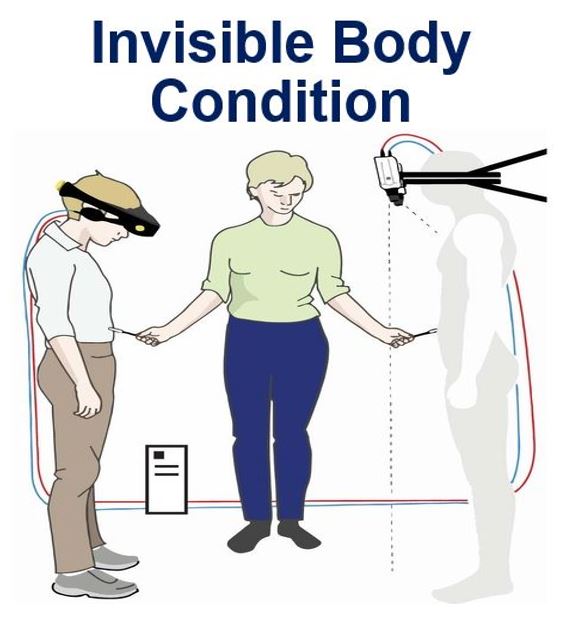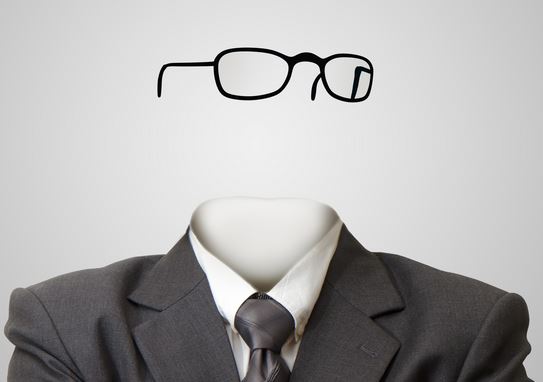People can be tricked into thinking they are invisible, researchers from the Karolinska Institute in Sweden showed. They reported in the journal Scientific Reports that individuals who thought they could not be seen felt relaxed, and believe their findings may be useful for future anxiety disorder therapy research.
Humans have long being fascinated by the power of invisibility. H.G. Wells wrote about it in his book The Invisible Man, as did J. K. Rowling when she introduced the invisibility cloak into the Harry Potter stories.
According to a team of neuroscientists, a perceptual illusion of being invisible has a calming effect on our physical stress response in difficult social situations.

The volunteer looks down and sees an empty space. Eventually he is duped into thinking he’s invisible. (Image: Nature)
Lead author Arvid Guterstam explains that recent advances in materials technology have shown that invisibility cloaking of larger objects, including the human body, might be possible in the not-so-distant future.
However, nobody knows how our brain and body perception might respond. So, he and his team tried to find out.
Volunteers wore virtual reality goggles
The scientists describe a perceptual illusion of having an invisible body, i.e. people believing they are invisible. In the experiment, volunteers stood up wearing a set of head-mounted displays. They were then asked to look down at their bodies, but instead of seeing a torso, lower arms and legs, they saw an empty space.
To induce a feeling of being invisible, the researchers touched the participant’s body in several locations with a large paintbrush, while the other hand, which was also holding a paintbrush, imitated the movements in mid-air in full view of the volunteer.
Guterstam explained:
“Within less than a minute, the majority of the participants started to transfer the sensation of touch to the portion of empty space where they saw the paintbrush move and experienced an invisible body in that position.”
“We showed in a previous study that the same illusion can be created for a single hand. The present study demonstrates that the ‘invisible hand illusion’ can, surprisingly, be extended to an entire invisible body.”
During the study, the team examined the illusion experience in 125 volunteers. To show that the illusion really worked, the scientists would make a stabbing motion with a knife toward the empty space that represented the stomach of the invisible body.

Participant with virtual reality-goggles. (Credit: Staffan Larsson)
At seeing the knife movement, the volunteers’ sweat response rose while they were under the illusion of being invisible. When they were not duped into thinking they were invisible, the same movement had no effect on their sweat response.
This suggested that their brain interpreted the threat in empty space as a threat directed toward their own body.
Invisibility and social anxiety
Guterstam and colleagues wanted to see how believing that one is invisible might affect social anxiety. They placed the volunteers in front of an audience of strangers.
Guterstam said:
“We found that their heart rate and self-reported stress level during the ‘performance’ was lower when they immediately prior had experienced the invisible body illusion compared to when they experienced having a physical body.”
“These results are interesting because they show that the perceived physical quality of the body can change the way our brain processes social cues.”

Would a perceptual illusion of having an invisible body help people with social anxiety disorder?
The team hopes that their findings may be of value to future clinical research, for example in the creation of new treatments for social anxiety disorder.
In an Abstract in the journal the authors concluded:
“This study provides an experimental model of what it is like to be invisible and shows that this experience affects bodily self-perception and social cognition.”
Head researcher, Prof. Henrik Ehrsson, said:
“Follow-up studies should also investigate whether the feeling of invisibility affects moral decision-making, to ensure that future invisibility cloaking does not make us lose our sense of right and wrong, which Plato asserted over two millennia ago.”
The study was funded by the Söderberg Foundation and the Swedish Research Council.
Citation: ‘Illusory ownership of an invisible body reduces autonomic and subjective social anxiety responses ’, Arvid Guterstam, Zakaryah Abdulkarim & Henrik Ehrsson, Scientific Reports online 23 April 2015, DOI: 10.1038/srep09831.
